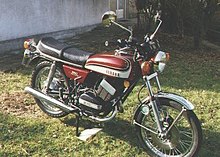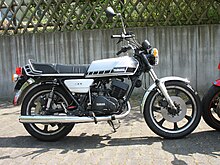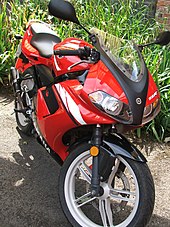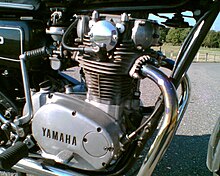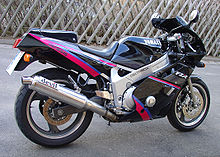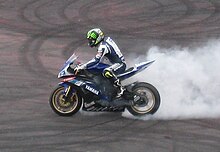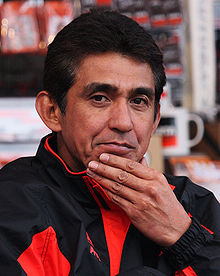Yamaha engine
| Yamaha Hatsudōki KK
|
|
|---|---|
| legal form | Kabushiki-gaisha (joint stock company) |
| ISIN | JP3942800008 |
| founding | July 1, 1955 |
| Seat |
Iwata , Japan |
| management | Yoshihiro Hidaka, President, Representative Director |
| Number of employees | 53,977 (end of 2018) |
| sales | 1.673 trillion JPY (2018) |
| Branch | Conglomerate, including automotive |
| Website | global.yamaha-motor.com |
| As of December 31, 2018 | |
The Yamaha Hatsudōki KK ( Japanese ヤ マ ハ 発 動機 株式会社 , Yamaha Hatsudōki kabushiki-gaisha ; English Yamaha Motor Company, Ltd. ) is a Japanese company with headquarters in Iwata , Japan . The conglomerate manufactures motorcycles , quads and motors (especially boat motors ) in the mobility division . The industrial division of the company manufactures and sells generators , pumps , robots , SMT - placement machines , drones , equipment for water treatment , swimming pools and other products.
The Yamaha Motor Company was founded in 1955 as a subsidiary of the Yamaha Corporation . Today Yamaha Motor is an independent group with 131 consolidated subsidiaries. The Yamaha Corporation still holds just under 10 percent of Yamaha Motor.
At the beginning of 2014, 566,762 Yamaha motorcycles were registered in Germany, which corresponds to a share of 13.98%.
history
The roots of the Yamaha Motor Company go back to 1887 when Torakusu Yamaha founded a company to manufacture musical instruments. From this in 1897 the Nippon Gakki (literally "Japan Musical Instruments") company developed and later the Yamaha Corporation . The Yamaha Motor company logo with the three tuning forks , which is derived from the logo of the Yamaha Corporation, is a reminder of the original business field of Yamaha .
In 1950 Genichi Kawakami took over the management of Nippon Gakki. In November 1953, he ordered the development of a motorcycle in order to add motorcycles to the product range in the future. In 1954, prototypes of the first model motorcycle, called the YA-1, were built. According to the company chronicle of the Yamaha Motor Company, the first copy of the YA-1 ready for sale was completed and delivered on February 11, 1955.
On July 1, 1955, the Yamaha Motor Company was founded as a subsidiary of Nippon Gakki. The young motorcycle division was spun off from Nippon Gakki. With financial support from the government, the Yamaha Motor Company began producing motorcycles.
The engine of the Toyota 2000 GT was developed by Yamaha. In the 1990s, together with the Ford Motor Company, Yamaha developed the Zetec-SE engine generation (4-cylinder four-stroke engines in series for transverse installation), which was used in the Ford models Fiesta, Puma and Focus or in a modified form is used (Ford Fiesta, Ford Focus). Zetec-SE engines were also used in various Mazda models. At times, Yamaha also built engines for Formula 1 .
Series / model series
Yamaha started the motorcycle production with two-stroke motorcycle series, which initially carried the abbreviations YA and DT (light off-road motorcycles). Subsequent model series with four-stroke engines began with the name Yamaha XS . Other series are known under the names XT , Yamaha R-Series , Yamaha XJ (and others).
Two-stroke
The first Yamaha motorcycle, the YA-1 , was also called the Red Dragonfly . Development work began in 1954 at Nippon Gakki, the later Yamaha Corporation. The Yamaha Motor Company was founded on July 1, 1955 as a subsidiary of Nippon Gakki and then took over production. The YA-1 was a copy of the DKW RT 125 . It had an air-cooled single-cylinder two-stroke engine with three-channel reverse scavenging , 123 cm³ displacement (52 mm bore × 58 mm stroke), 5.6 hp (4.1 kW) power at 5000 rpm and a top speed of 80 km / h.
In 1958 the YA-2 with 125 cc and one more horsepower took over, followed in 1959 by the YA-3 .
In 1961 the YA-5 already produced 10 HP (7.4 kW), in 1963 the YAT-1 was derived, which was adapted to the appearance of the 250 twin and competed with the Yamaha against Honda, which offered the similar Honda CB 92 .
These motorcycles flowed into a line with powerful two-cylinder two-stroke engines, which were characterized by high torque and acceleration. First, the YDS3 model came onto the German market in 1964 , a 250 cc two-cylinder machine with 24 hp (18 kW) that was already very well sold in America. Subsequently, the models YDS5E , DS6 (both with 250 cm³) as well as YR1 , YR2 and R3 (all with 350 cm³) were offered in Germany until the early 1970s . With the models DS-7 (250 cm³, 24 PS (18 kW)) and R-5 (350 cm³, 36 PS (26 kW)) the lines of development of the 350 and 250 models were merged. Both models now had a horizontally divisible motor housing, were slot-controlled and equipped with drum brakes.
In Japan the 1972 models were still called DX250 PRO and RX350 PRO and stood between the DS7 and RD 250 or the R5-F and RD 350 .
The air-cooled successor models RD 250 and RD 350 (identical in construction to RD 250, only 100 cm³ more displacement) are considered to be the best-selling motorcycles to this day . They were delivered in 1973 with 30 and 39 hp. The intermediate model RD 250-B had 32 hp in 1976. After the insurance classes were changed, the RD 250 was later throttled to 27 hp in Germany.
The diaphragm valves in the suction side of the intake tract were a technical innovation. This technology improved the gas exchange in the engine and expanded the usable speed range. These models had a disc brake at the front and achieved high performance. The liveliness of the motor was also a result of the "five-port (five-channel) control", which had been further developed from Adolf Schnürle's patented reverse flush . Due to the principle of the two-stroke engine, the exhaust gases from the fresh gasoline-air mixture are pressed into the exhaust, and part of the fresh gas also enters the exhaust. Thanks to the clever ducting of the five-port system , the fresh gases in the form of a closed front press the used gases specifically into the exhaust without mixing with the exhaust gases, as was the case with earlier designs. Due to the special design of the exhaust system ( resonance exhaust ) for high-performance two- stroke engines, the pressure wave that escapes from the cylinder when the exhaust port is opened is also reflected and pushes the excess fresh gases back into the cylinder before the piston closes the compression window. As a result, the filling of the cylinder is improved at resonance speed, which enables a considerable increase in performance, which finally made the two-stroke engines of the time superior to the four-stroke engines with the same displacement. However, this type of resonance charging only works in a narrow engine speed range, which quickly earned the two-stroke engines built in this way the reputation of having excellent and difficult-to-control performance characteristics. Yamaha did not invent this form of increasing the performance and efficiency of two-stroke engines, but used it for the first time in series production on motorcycles.
The two-stroke models from Yamaha have had separate lubrication (fresh oil lubrication) since they were first sold in Germany. In contrast to the usual two-stroke engine, gasoline and engine oil did not have to be mixed. At Yamaha, an oil pump supplied the fuel-air mixture with dosed lubricating oil from a separate oil tank for engine lubrication, depending on the speed and the position of the throttle grip . Piston jams in overrun operation were very rare with these models, as adequate lubrication was always guaranteed, at least at low speeds.
The RD 400 model came onto the market in 1977/78 (internal designation 1A3) as a replacement for the very narrow, air-cooled predecessor model RD 350, the engine output was 32 kW (43 hp). In 1979 Yamaha modernized the model with contactless transistor ignition , revised footrest system (the one-piece, continuous footrest carrier previously attached under the frame ran below the connection between the exhaust manifold and the rear silencer and had caused dangerous situations by touching down when driving fast in curves with a corresponding incline on uneven road surfaces) and new design. The internal designation was 2 R 9; In this model, the footrest supports were attached separately to the frame on the right and left above the exhaust system. For both versions, there were still thicker cylinder head gaskets, as the models equipped with contact ignition in particular tended to use the notorious “money box” (burning through of the piston crown) if the pre-ignition setting was neglected. The version 2 R 9 was granted only a short production time, as the water-cooled versions of the RD models were delivered to the European market as early as 1980 , thus finally ending the era of the air-cooled two-stroke engines at Yamaha.
In 1980, Yamaha brought an innovation: based on the two-stroke racing machines that were successful in racing, the water-cooled models RD 250 LC and RD 350 LC - RD 350 - came onto the market as street versions . In 1983 the RD 350 YPVS came as a further development . The YPVS (Yamaha Power Valve System), which originated in racing, helped the small two-stroke engine to produce 43 (59), later 46 kW (63 hp) as standard - which enabled 500 to 750 four-stroke machines to achieve performance. The YPVS system uses a roller to vary the height of the exhaust duct and thus the effective expansion of the engine. The outlet cross-section is adapted to the current engine speed, which makes the performance characteristics considerably softer and a high torque is generated even at lower speeds, which makes the machine easier to drive. At the same time, the design can be adapted accordingly for higher speeds, which increases the possible peak performance. As the speed increases, the height of the exhaust port increases, which shifts the maximum torque to higher speeds. A system called YEIS (Yamaha Energy Induction System) was installed in the intake duct of the single-cylinder engine of the RD 125 LC .
It consisted of a chamber that branched off from the intake manifold in front of the diaphragm-controlled inlet. The mixture that remained in front of the diaphragm when the speed decreased (e.g. when braking before a curve) collected in this chamber and escaped from the chamber again when there was a higher negative pressure in the intake tract (e.g. when accelerating in or after the Curve). As a result, the engine's throttle response has been significantly improved, fuel consumption has been reduced by up to 10% and the drivability of the Yamaha two-stroke motorcycles has been further improved. The last development stage was the RD 500 V4 in 1984 - a replica of the multiple world championship machine in the 500 class ( Wayne Rainey , Eddie Lawson ). The V4 two-stroke engine developed 65 kW (88 hp) as standard. This made the RD 500 one of the fastest street motorcycles of its time. In good condition, it can keep up with modern sports machines because of its performance and good handling. Equipped with modern chassis components, the Yamaha RD500 are still competitive with modern road-legal sports motorcycles due to their handling and sufficient engine power (which can be increased relatively easily) in terms of driving performance. However, despite the basically simpler two-stroke principle, the machine had to be built with so much effort that this engine concept had no future, especially since stricter exhaust and noise emission laws no longer had to be complied with.
The newest two-stroke is the Yamaha TZR50R . In Germany, this was taken off the market after only a short time due to the lack of sales success. Rumors that this type of vehicle was banned because it is said to have been involved in many accidents are false, as is the legal basis for banning a certain type of vehicle from a manufacturer due to the frequency of accidents in Germany. In contrast, the motorcycle is a best seller in Switzerland and is therefore one of the motorcycles that can be seen most frequently on Swiss roads.
Four-stroke

In 1969, Yamaha launched a new line with a parallel twin, the XS 1 . Visually very similar to classic British motorcycles, the 650 cm³ engine is equipped with an overhead, chain-driven camshaft ( OHC ) and has a primary drive through spur gears. The further development resulted in the XS 650 , which appeared in Germany in 1974 and was built in various versions until 1984. It initially had 51, later 50 HP, was equipped with an electric starter and was a bestseller because of its reliability and its "English" look.
In 1972 the two-cylinder model TX 750 appeared , at the time the largest and most powerful four-stroke motorcycle that Yamaha offered - albeit only briefly, because the new two-cylinder machine was against the long-established four-cylinder Honda CB750 Four despite the technical delicacy of the two chain-driven balance shafts to dampen vibrations ("Omni-Phase-Balancer-System" - for the first time in motorcycle construction) unsuccessful: the balancer shaft drive chain often elongated or even tore and thus caused a total engine failure. The oil got too hot during long motorway journeys, which was remedied with a retrofitted oil cooler. The between the two exhaust pipes before the cylinder head located interference tube led to further thermal problems. Because of the warranty work associated with it for Yamaha, the model was discontinued in 1974.
In 1973, Yamaha brought out the TX 500 / XS 500 B, a four-stroke motorcycle with two cylinders, which was the first production motorcycle to have a four-valve engine after the Second World War. The thermally highly stressed cylinder head turned out to be not entirely unproblematic. It was built in different versions as the XS 500 C / D / E until 1979.
In 1975 Yamaha delivered the indestructible XT 500, the first series model of an enduro , equipped with a 500 cc single-cylinder four-stroke engine. This machine is still very popular today. Another popular young timer is the SR 500 with the almost identical single-cylinder engine, which was launched in Germany in 1978. It was one of the most popular motorcycles of the 1980s. Today it is a cult machine among the “youngtimers” and is enjoying growing popularity. The SR400 has been available as an identical new edition of the classic since 2014 (no longer sold in Germany since the end of 2016). The differences are the smaller displacement and an injection system. There were also two little sisters in Germany: SR250 (1980–1982) and XT250 (1979–1989), which used the same single-cylinder engine with 250 cc.
From 1976, the two-cylinder OHC model XS360 was built in the displacement class below 500 cm³ , and from 1978 onwards it was sold with an enlarged displacement as the XS400 . A version with 250 cm³ was also produced as the XS250. From 1983 a new XS400 was built , now with a DOHC engine. These machines are still valued today as inexpensive entry-level motorcycles due to their ease of maintenance and reliability.
The three and four-cylinder models of the four-stroke series XS750 , XS850 (three-cylinder) and XS1100 (four-cylinder) and 95 hp, which came out at the end of the 1970s, became a great success story . The XS 1100 was the largest motorcycle in the world when it was launched. These motorcycles were the first Japanese motorcycles to have a cardan secondary drive, which was created as a development contract at Porsche in Weissach with double deflection at the gearbox output and rear wheel .
With these machines and the more sporty successor four-cylinder engines ( XJ550 and later XJ600S (Diversion) or N with chain and XJ650 , XJ750 and XJ900 with cardan drive), Yamaha established itself in the promising market of large touring and sports motorcycles. A tourer model offered between 1981 and 1985 , the TR1 with a fully encapsulated drive chain and a 981 cm³ transverse V-cylinder (similar to Harley-Davidson ), was less successful on the market. In 1984 the FJ1100 was introduced , which was originally planned as a sports motorcycle and was equipped with a chain.
Under the model designation Virago Yamaha produced from 1981 to 2003 more both warp and cardan-driven chopper - and Cruiser -Modellbaureihen 125-1100 cc engine capacity . The Virago models have been exported to many countries around the world. The model designation in Germany was “XV” (e.g. XV535, XV1100 etc.), whereby the XV 535 is one of the best-selling motorcycles in Germany with over 30,000 units sold.
In 1993, a successor to the FJ series was presented with the GTS1000 and the model variant GTS1000A (with ABS). The GTS1000 was the first mass-produced motorcycle with a stub axle steering. In conjunction with electronic injection, regulated 3-way catalytic converter and optional ABS, the GTS1000 was considered a technology carrier that had only limited commercial success due to its high price.
The XJR, which was built from 1995 to 2016, was for a long time the only motorcycle in the XJ series that was offered without a shaft drive .
The FZR model series represented the sporty side of Yamaha. Production started with the FZR400, which was soon followed by larger engines. There were other models and engine variants, including the FZR 600 (91 and 98 PS), FZ 750 (98–115 PS) and FZR1000 (2LA, 98–135 PS) / FZR1000 (3LE, up to 106 kW / 146 PS) . At that time, these were all super sports models. But there were also the uncovered FZR series, for example the Yamaha FZX750 .
The successors to the FZR generation were the YZF600R "Thundercat" , the YZF750R / SP and the YZF1000R "Thunderace" . Except for forged pistons, the 1000 Thunderace has the same engine as the FZR1000 (3LE), but with 107 kW (145 HP).
With the undisguised “muscle bike” V-Max , Yamaha created a cult motorcycle that was built from 1984 onwards. The international, "open" version of its 1200 V4 engine produces up to 107 kW (145 PS), which has long been unsurpassed and made the motorcycle unrivaled in terms of acceleration. At high speeds, however, the V-Max is difficult to drive in the standard trim because the chassis cannot cope with the engine power and tends to oscillate. Machines officially imported into Germany were throttled down to 98 hp, which is affordable for insurance. The voluntary restriction of manufacturers and importers officially limited the output of machines sold in Germany to 100 hp since around 1982; the result of a discussion about ever more powerful motorcycles triggered by the Honda CBX-1000 six-cylinder with 105 hp at the end of the 1970s. In 2009 the 200 hp mark was reached for the first time with a completely new Vmax on a mass-produced motorcycle. Their 1680 cc four-cylinder V engine produced this output at 9000 rpm; the top speed was limited to 220 km / h.
In 1998 Yamaha introduced the YZF-R1 . It is a thoroughbred street-legal superbike with 998 cm³ and 110 kW (150 PS) - with compact external dimensions and a fueled weight of less than 200 kg. With this machine, Yamaha impressively demonstrated its engineering skills and proved that you can achieve high performance even from comparatively small engines.
The FJR1300 since its release in 2001, seven times (series) winner by the readers "Motorcycle of the Year" of the magazine MOTORCYCLE. With its 143.5 hp (105.5 kW) at 8,000 rpm and a maximum torque of 134.4 Nm at 7000 rpm, it established the new segment of performance touring bikes within the touring class.
In 2010, Yamaha introduced a new travel enduro , the XT1200Z Super Ténéré . The new machine's two-cylinder, four-stroke, in-line engine develops 110 hp (80.9 kW) at 7,250 rpm and a maximum torque of 114.1 Nm at 6,000 rpm.
Star Motorcycles
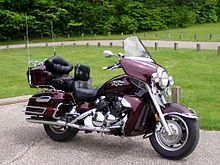
In 1994 Yamaha announced the founding of the Star Motorcycles brand , under which cruisers with V2 engines were to be sold on the American market. In 2006, Star Motorcycles was spun off into its own company, with Yamaha continuing to take over production and sales. The company is headquartered in Cypress , California . The design of the motorcycles is also developed in the USA. All models are based on a V2 engine and are clearly positioned as competition to Harley-Davidson motorcycles .
At the moment (beginning of 2016) model variants based on the XV1900A (Raider, Stratoliner and Roadliner), on the XV1600 (Road Star), on the XVS1300 (Stryker and V Star), the XV950 (Bolt and V Star) as well as the XVS650 and XVS250 are available (V Star).
Car
At the Tokyo Motor Show 1983 a single-seat microcar called the PTX-1 was presented, which had an engine with 50 cc, but did not go into production.
Between 1992 and 1993 the super sports car OX 99-11 was developed, which also did not go into series production. The vehicles were powered by a V12 engine with a capacity of 3500 cc and 400 hp.
Range of models in the mobility division
motorcycles
Currently (2019) Yamaha sells models in Germany with the following engines:
| design type | Displacement | Super sport | Naked bike | Retro | Sports Tourer | Travel enduros | comment |
|---|---|---|---|---|---|---|---|
| R4 | 1298 cc | ||||||
| R2 | 1199 cc | ||||||
| R4 | 998 cc | ||||||
| V2 | 942 cc | ||||||
| R3 | 847 cc | ||||||
| R2 | 689 cc | A2 driving license with throttle | |||||
| R4 | 599 cc | ||||||
| R2 | 321 cc | A2 driving license | |||||
| R1 | 124.7 cm³ | Light motorcycles | |||||
| R1 | 125 cc | air-cooled, light motorcycle |
Scooter
Currently (2019) Yamaha sells models in Germany with the following engines:
They are all liquid-cooled four-stroke engines.
| design type | Displacement | Models |
|---|---|---|
| R1 | ~ 50 cm³ | |
| R1 | 115 cm³ |
|
| R1 | ~ 125 cc |
|
| R1 | 124 cc |
|
| R1 | 292 cc |
|
| R1 | 395 cc |
|
| R2 | 530 cc |
|
Quads
- Quads for work ( Yamaha Grizzly and Yamaha Kodiak )
- Grizzly 350 2WD
- Grizzly 450 IRS / EPS
- Grizzly 700 EPS / SE
- Kodiak 450 EPS / SE
- Kodiak 700 EPS / SE
- Quads for sport and leisure ( Yamaha YFM and Yamaha YFZ )
- YFZ 50
- YFM 90 R
- YFZ 450 R / SE
- YFM 700 R / SE
The "R" at the end of the model name stands for "Raptor". However, for licensing reasons, this name may not be used by Yamaha in Germany.
- Side-by-side vehicles ( Yamaha Wolverine )
Personal watercraft
Personal watercraft are Yamaha under the name WaveRunner offered in three series:
- High performance models (FX series)
- Compact models (EX and VX series)
- Sport models (GP 1800 and VXR)
There is also the SuperJet model for use in motorsport competitions .
Boat engines
Yamaha has been selling outboard motors in Germany since 1963 . The first two models were air-cooled two-stroke single-cylinder engines with an output of 4 and 8 hp . Yamaha currently only sells outboards as four-stroke engines in Europe. In the current program from 2016, the smallest model is a 2.5 HP engine with one cylinder and 72 cm³ displacement, the most powerful model (F350) has 350 HP, eight cylinders in a V arrangement and 5330 cm³ displacement. Furthermore, electric outboard motors are in the Yamaha marine program. Yamaha also produced inboard engines as diesel or gasoline engines and sterndrives.
Others
- Inflatable boats are offered under the names YAM and Ribey . The length in centimeters can be seen from the type designation.
- Snowmobiles
- Golf cars
- two-seat off-road vehicles
- Drives for e-bikes
Industrial products
Motorsport

Motorcycle world championship
So far, Yamaha has clinched a total of 37 drivers ' and 38 constructors' titles in the motorcycle world championship .
Driver title:
![]() Phil Read (5)
Phil Read (5)
- World champion in the 125 cm³ class: 1968
- World champion in the 250 cm³ class: 1964 , 1965 , 1968 , 1971
![]() Valentino Rossi (4)
Valentino Rossi (4)
![]() Eddie Lawson (3)
Eddie Lawson (3)
![]() Jorge Lorenzo (3)
Jorge Lorenzo (3)
![]() Wayne Rainey (3)
Wayne Rainey (3)
![]() Kent Andersson (2)
Kent Andersson (2)
![]() Giacomo Agostini (2)
Giacomo Agostini (2)
![]() Carlos Lavado (2)
Carlos Lavado (2)
![]() Bill Ivy (1)
Bill Ivy (1)
- World champion in the 125 cm³ class: 1967
![]() Rodney Gould (1)
Rodney Gould (1)
- World champion in the 250 cm³ class: 1970
![]() Jarno Saarinen (1)
Jarno Saarinen (1)
- World champion in the 250 cm³ class: 1972
![]() Dieter Braun (1)
Dieter Braun (1)
- World champion in the 250 cm³ class: 1973
![]() Johnny Cecotto (1)
Johnny Cecotto (1)
- World champion in the 350 cm³ class: 1975
- World champion in the 350 cm³ class: 1977
- World champion in the 250 cm³ class: 1982
![]() Christian Sarron (1)
Christian Sarron (1)
- World champion in the 250 cm³ class: 1984
![]() John Kocinski (1)
John Kocinski (1)
- World champion in the 250 cm³ class: 1990
![]() Tetsuya Harada (1)
Tetsuya Harada (1)
- World champion in the 250 cm³ class: 1993
![]() Olivier Jacque (1)
Olivier Jacque (1)
- World champion in the 250 cm³ class: 2000
Superbike World Championship
Overall, Yamaha has so far been able to win one driver and one constructor world championship in the Superbike World Championship .
Driver title:
![]() Ben Spies (1)
Ben Spies (1)
- Superbike World Champion: 2009
World Supersport Championship
So far, Yamaha has won five drivers 'and five constructors' titles in the Supersport World Championship .
Driver title:
![]() Jörg Teuchert (1)
Jörg Teuchert (1)
- Supersport World Champion: 2000
![]() Cal Crutchlow (1)
Cal Crutchlow (1)
- Supersport World Champion: 2009
![]() Chaz Davies (1)
Chaz Davies (1)
- Supersport World Champion: 2011
![]() Sam Lowes (1)
Sam Lowes (1)
- Supersport World Champion: 2013
![]() Lucas Mahias (1)
Lucas Mahias (1)
- Supersport World Champion: 2017
![]() Sandro Cortese (1)
Sandro Cortese (1)
- Supersport World Champion: 2018
- Supersport World Champion: 2019
Motorcycle speed record
Don Vesco set the motorcycle speed record in 1970 ( Big Red , 405 km / h ) and 1975 ( Silver Bird , 487 km / h) on streamlined machines fitted with Yamaha engines .
Racing boating
Yamaha outboard motors (2-stroke) are mainly used in racing boats in the class up to 850 cm³. In this Formula 4, drivers with Yamaha engines won six world and four European championship titles between 1999 and 2009. At the beginning of the 1990s, riders with Yamaha outboards also competed in the triangular file class up to 400 cm³. They won three world and two European titles.
formula 1
From 1989 to 1997 , Yamaha was involved in Formula 1 as an engine supplier. During this time, the company exclusively equipped a team that received the engines free of charge. Initially the engines were designed in Japan, later Yamaha received support from the British engine manufacturer Engine Developments (“Judd”). In eight years, cars powered by Yamaha engines earned 36 world championship points. The best individual result was the second place at the Hungarian Grand Prix 1997 ( Damon Hill on Arrows ), the best season was 1994 , when Tyrrell- Yamaha scored 13 world championship points.
Zakspeed
After Yamaha had been producing engines for the Japanese Formula 2 series for a number of years, the company turned to Formula 1 with the start of the so-called new naturally aspirated engine era in 1989. The first customer team was the German racing team Zakspeed , which had self-designed turbo engines to the start from 1985 to 1988 . Yamaha constructed an eight-cylinder engine with a displacement of 3.5 liters and an output of 580 hp. This made it the weakest engine that was used in 1989. The engine, which Yamaha described in retrospect as the "hobby of some enthusiasts", proved to be immature and unreliable, and the Yamaha technicians were overwhelmed with the comparatively demanding technology. The timing belt and the resulting susceptibility to load changes were the cause of numerous engine damage, which often led to failures during training.
The results of the effort have been sobering. Zakspeed's driver Bernd Schneider was only able to qualify for two of 16 races in 1989 and then retired with a technical defect. His team-mate Aguri Suzuki missed the qualification on every attempt. After EuroBrun Racing, Zakspeed was the worst team of the 1989 season. Yamaha was ready to supply the German team with engines free of charge in 1990 as well. However, Zakspeed did not manage to sign sponsors for another Formula 1 year. In February 1990, team boss Erich Zakowski therefore announced that his racing team would withdraw from Formula 1 after five years.
Brabham
In 1990 Yamaha could not find a partner team in Formula 1. In 1991 , an alliance was formed with the British team Brabham , which was financially troubled. Brabham received completely redesigned twelve-cylinder engines, which were again provided free of charge. Martin Brundle brought the Brabham BT59Y used in the first two races of the year and the newly designed BT60Y to the finish line nine times; his best result was fifth in the engine maker's home race, the Japanese Grand Prix . Mark Blundell , his teammate, made five finishings, including a sixth place in Hungary . Towards the end of the season, the team's performance waned; both drivers occasionally had difficulties with the qualification or pre-qualification. Brabham-Yamaha finished the season with three points in tenth in the constructors' championship.
Jordan Grand Prix
In 1992 , Yamaha awarded the engine to the Jordan Grand Prix , which had restarted the year before , and which appeared to be technically better positioned and expected better results than Brabham. However, Jordan had put a lot of financial strain on himself in his debut season and could only afford little development work in 1992, which is why the vehicle used, the Jordan 192 , was essentially a mere adaptation of the previous year's vehicle to the new engine. The car suffered from a lack of reliability; besides, the qualification was never certain. Maurício Gugelmin only crossed the finish line five times - outside of the points in each case - and Stefano Modena , who was signed as the top driver, regularly retired in the first eleven races of the year with technical defects. He failed to qualify four times. With his sixth place at the Australian Grand Prix , he secured his team the only championship point of the year.
Gary Anderson, Jordan’s chief designer, was in retrospect critical of the Yamaha twelve-cylinder. In his opinion, the Yamaha engineers have never properly grasped the requirements placed on a racing engine. The Yamaha OX99 would therefore have had problems with overheating - in addition to the deficits in weight and performance already mentioned - which would have required disproportionately large coolers. Stefano Modena was quoted on the performance of the OX99 as saying that the Jordan 192 could have been brought to a standstill by holding a finger in front of the vehicle's nose.
Alliance with Judd and Tyrrell
In 1993 Yamaha realigned its Formula 1 involvement. Instead of frequent changes of partner teams, Yamaha now joined forces on a long-term basis - i. H. for initially four years - with the traditional British racing team Tyrrell . This should enable continuous further development. In addition, Yamaha now cooperated with Engine Developments, a British engine manufacturer that had previously produced engines for Formula 1 under the name "Judd" (after its founder John Judd). The Yamaha engine for the 1993 season was a ten cylinder unit technically based on the 1991 Judd GV engine. Engine Developments was responsible for the construction and maintenance of the engines and looked after the engines on the racetrack.
The alliance with Tyrrell was unsuccessful in the first year: With problematic, sometimes outdated cars, the team did not score a single World Championship point in 1993. In the following year, however, there were already 13 world championship points and with third place Mark Blundell at the Spanish Grand Prix the first podium position for a driver with a Yamaha engine. For the 1995 season , Tyrrell-Yamaha was considered an insider tip, and for the first time in a long time the team had a large, financially strong sponsor in Nokia . But Tyrrell did not live up to expectations. The company did not manage to master the technical challenges that resulted from the conversion from 3.5 liters to 3.0 liters displacement. The modified Yamaha engines were unreliable and caused numerous technical failures. It was only in the last six races of the year that Mika Salo managed to finish three races in the points. With five world championship points, Tyrrell-Yamaha finished ninth in the constructors’ championship. The situation was similar in the 1996 Formula 1 season. Salo drove again only five world championship points, which this time were enough for eighth place in the constructors championship.
Arrows
At the end of the 1996 season, Yamaha decided to end the alliance with Tyrrell. The company turned to the rival Arrows team , which appeared to be on the up thanks to new team boss Tom Walkinshaw . In 1997, last year's Formula 1 world champion Damon Hill drove for Arrows, so better performances than in the previous year were to be expected. However, this season was also problematic; regular positioning on the podium, which Hill had expected, did not materialize. Hill mostly drove in midfield. Only at the Hungarian Grand Prix was the race described in the press as the “Miracle of Hungary”, in which Hill led the field for a long time. Nevertheless, there was no victory; after a failure of the Hills hydraulic pump , his pursuer Jacques Villeneuve managed to take the lead and win the race. Hill finished second and got the best result for a car with a Yamaha engine. Regardless of this success, Yamaha ended its Formula 1 involvement at the end of the 1997 season.
Overview: Formula 1 teams with Yamaha engines
| season | Engine type | Displacement and cylinders | team | chassis | driver | World Cup points | World Cup place |
|---|---|---|---|---|---|---|---|
| 1988 | Yamaha OX88 | 3.5 liter V8 | West Zakspeed Racing | Zakspeed 891 |
Bernd Schneider Aguri Suzuki |
0 | - |
| 1991 | Yamaha OX99 V12 | 3.5 liter V12 | Motor Racing Developments | Brabham BT60Y |
Martin Brundle Mark Blundell |
3 | 10 |
| 1992 | Yamaha OX99 | 3.5 liter V12 | Sasol Jordan Yamaha | Jordan 192 |
Stefano Modena Maurício Gugelmin |
1 | 11 |
| 1993 | Yamaha OX10A | 3.5 liter V10 | Tyrrell Racing Organization |
Tyrrell 020C Tyrrell 021 |
Andrea de Cesaris Ukyō Katayama |
0 | - |
| 1994 | Yamaha OX11B | 3.5 liter V10 | Tyrrell | Tyrrell 022 |
Mark Blundell Ukyō Katayama |
13 | 7th |
| 1995 | Yamaha OX10C | 3.0 liter V10 | Nokia Tyrrell Yamaha | Tyrrell 023 |
Mika Salo Gabriele Tarquini Ukyō Katayama |
5 | 9 |
| 1996 | Yamaha OX 11A | 3.0 liter V10 | Tyrrell Yamaha | Tyrrell 024 |
Mika Salo Ukyō Katayama |
5 | 8th |
| 1997 | Yamaha OX11A | 3.0 liter V10 | Danka Arrows Yamaha | Arrows A18 |
Damon Hill Pedro Diniz |
9 | 8th |
literature
- Joachim Kuch: Yamaha: Motorbikes since 1970 - Type Compass - Basic knowledge for motorcycle fans , Motorbuch-Verlag Stuttgart, 2005, ISBN 3-613-02460-8
Web links
- Yamaha Motor international website
- Yamaha Motor Europe
- Yamaha Motor Germany
- Yamaha Motor Austria
- Yamaha Motor Switzerland
- Yamaha Motorsport (German)
- Star Motorcycles Official site
Individual evidence
- ↑ a b c d e Overview global.yamaha-motor.com, accessed September 8, 2019.
- ↑ Products global.yamaha-motor.com (English)
- ↑ Group comanies yamaha-motor.com
- ↑ floor information global.yamaha-motor.com
- ↑ kba.de FZ 17 (accessed on April 28, 2015)
- ↑ History of Logo yamaha.com
- ^ A b 1953–1955: Entering the Motorcycle Market and Establishing Yamaha Motor Co., Ltd. global.yamaha-motor.com
- ^ A b George Nick Georgano (Editor-in-Chief): The Beaulieu Encyclopedia of the Automobile. Fitzroy Dearborn Publishers, Chicago 2001, ISBN 1-57958-293-1 , pp. 1773-p. 1774. (English)
- ↑ Company advertisement in the magazine The Yacht (Bielefeld), No. 1/1963, p 58
- ↑ Electric drives from Yamaha for e-bikes global.yamaha-motor.com
- ↑ Products: Industrial global.yamaha-motor.com
- ↑ without team class
- ↑ Database query at the Schulze racing boat archive on May 23, 2010
- ↑ The Cosworth DFR engine and the Judd EV developed 610 hp, the Honda RA 109E of the McLaren team already had 670 hp. See overview at Cimarosti: Das Jahrhundert des Rennsport, p. 407.
- ↑ a b Michael Schmidt: Ripe from the island. The insider tips for 1995: Tyrrell-Yamaha and Jordan-Peugeot . In: Sport Auto, issue 2/1995, pp. 62,64.
- ^ Ménard, p. 602.
- ↑ Auto Motor und Sport, Issue 22/1989, p. 313.
- ^ Maurice Hamilton: Race Without End. The grind behind the glamor of the Sasol Jordan Grand Prix Team . Patrick Stephens Limited, Sparkford 1994, ISBN 1-85260-500-6 , pp. 22 (English).


